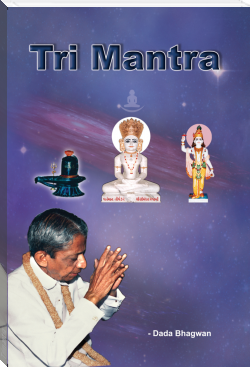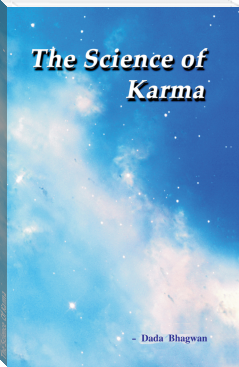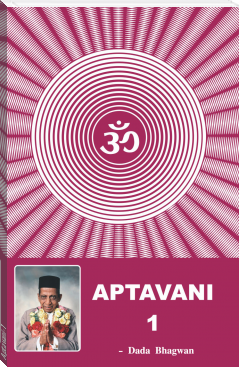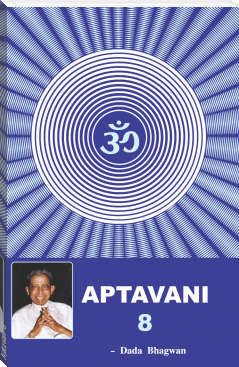The Hidden Meaning of Truth and Untruth by Dada Bhagwan (readnow .TXT) 📕

- Author: Dada Bhagwan
Book online «The Hidden Meaning of Truth and Untruth by Dada Bhagwan (readnow .TXT) 📕». Author Dada Bhagwan
As Expounded by Dada Bhagwan
The Hidden Meaning of Truth and Untruth
Originally complied in Gujarati Dr. Niruben Amin
Dr. Niruben Amin
Trimantra
The Three Mantras that Destroy All Obstacles in Life
Namo Vitaragaya
I bow to the One who is absolutely free from all attachment and abhorrence
Namo Arihantanam
I bow to the living One who has annihilated all internal enemies of anger, pride, deceit and greed
Namo Siddhanam
I bow to the Ones who have attained the state of total and final liberation
Namo Aayariyanam
I bow to the Self-realized masters who impart knowledge of liberation to others
Namo Uvazzayanam
I bow to those who have received the Knowledge of the Self and are helping others attain the same
Namo Loye Savva Sahunam
I bow to all saints everywhere who have received the Knowledge of the Self
Eso Pancha Namukkaro
These five salutations
Savva Pavappanasano
Destroy all demerit karma
Mangalanam cha Savvesim
Of all that is auspicious
Padhamam Havai Mangalam
This is the highest
Om Namo Bhagavate Vasudevaya
I bow to all who have attained the absolute Self in human form
Om Namah Shivaya
I bow to all human beings who have become instruments for salvation of the world
Jai Sat Chit Anand
Awareness of the Eternal is Bliss
Who Is Dada Bhagwan ?
In June 1958, around 6 o’clock one evening, amidst the hustle and bustle of the Surat railway station while seated on a bench, ‘Dada Bhagwan’ manifested completely within the sacred bodily form of Ambalal Muljibhai Patel. Nature revealed a remarkable phenomenon of spirituality! In the span of an hour, the vision of the universe was unveiled to him! Complete clarity for all spiritual questions such as, ‘Who are we? Who is God? Who runs the world? What is karma? What is liberation?’ etc. was attained.
What He attained that evening, He imparted to others through his original Scientific experiment (Gnan Vidhi) in just two hours! This has been referred to as the Akram path. Kram means to climb up sequentially, step-by-stepwhile Akram means step-less, a shortcut, the elevator path!
He, himself, would explain to others who Dada Bhagwan is by saying, “The one visible before you is not Dada Bhagwan. I am the Gnani Purush and the One who has manifested within is Dada Bhagwan who is the Lord of the fourteen worlds. He is also within you, and within everyone else too. He resides unmanifest within you, whereas here [within A. M. Patel], He has manifested completely! I, myself, am not God (Bhagwan); I also bow down to the Dada Bhagwan who has manifest within me.”
The Current Link to Attain Self-Realization
After attaining the Knowledge of the Self in 1958, absolutely revered Dada Bhagwan (Dadashri) traveled nationally and internationally to impart spiritual discourse and Self-realization to spiritual seekers.
During his lifetime itself, Dadashri had given the spiritual power to Pujya Dr. Niruben Amin (Niruma) to bestow Self-realization to others. In the same way, after Dadashri left his mortal body, Pujya Niruma conducted spiritual discourses (satsang) and imparted Self-realization to spiritual seekers, as an instrumental doer. Dadashri had also given Pujya Deepakbhai Desai the spiritual power to conduct satsang. At present, with the blessings of Pujya Niruma, Pujya Deepakbhai travels nationally and internationally to impart Self-realization as an instrumental doer.
After Self-realization, thousands of spiritual seekers prevail in a state free from bondage and dwell in the experience of the Self, whilst carrying out all their worldly responsibilities.
Note About This Translation
Param Pujya Dadashri’s spiritual discourses were in the form of answers to questions asked by spiritual aspirants. These discourses were recorded and compiled into books.
Dadashri had said that it would be impossible to translate His satsangs and the Knowledge about the Science of Self-realization word-for-word into English, because some of the meaning would be lost in the process. Therefore, in order to understand precisely the Akram Science of Self-realization, He stressed upon the importance of learning Gujarati.
Dadashri did however grant His blessings to translate His words into English and other languages so that spiritual seekers could benefit to a certain degree and later progress through their own efforts. This book is not a literal translation, but great care has been taken to preserve the essence of His original message.
For certain Gujarati words, several English words or even sentences are needed to convey the meaning, hence many Gujarati words have been retained within the English text for better understanding. At the first instance in your reading, the Gujarati word will be italicized followed by a translation explaining its meaning in round brackets. Thereafter, the Gujarati word will be used in the text that follows. This serves a two-fold benefit; firstly, ease of translation and reading and secondly, it will make the reader more familiar with the Gujarati words, which is critical for a deeper understanding of this spiritual Science. The content in square brackets provides further clarity in English which is not present in the original Gujarati content.
Special Note to the Reader
The Self is the Soul (Atma) within all living beings.
The term pure Soul is used by the Gnani Purush for the awakened Self, after the Gnan Vidhi. The word Self, with an uppercase ‘S’, refers to the awakened Self which is separate from the worldly-interacting self, which is written with a lowercase ‘s’.
Wherever Dadashri uses the term ‘we’, ‘us’, or ‘our’, He is referring to Himself, the Gnani Purush.
Similarly, the use of You or Your in the middle of a sentence, with an uppercase first letter, or ‘You’, ‘Your’ in single quotes at the beginning of the sentence, refers to the state of the awakened Self or Pragnya. This is an important distinction for the correct understanding of the difference between the awakened Self and the worldly-interacting self.
Wherever the name ‘Chandubhai’ is used, the reader should substitute his or her name and read the matter accordingly.
The masculine third person pronoun ‘he’ and likewise the object pronoun ‘him’ have been used for the most part throughout the translation. Needless to say, ‘he’ includes ‘she’ and ‘him’ includes ‘her’.
For your reference, a glossary of all the Gujarati words is either provided at the back of the book or available on our website at:
http://www.dadabhagwan.org/books-media/glossary/
While reading this English translation, if you feel there is any contradiction or discrepancy, then it is the mistake of the translators and the understanding of the matter should be clarified with the living Gnani to avoid misinterpretation.
Editorial
Every seeker of salvation makes painstaking effort to attain the truth, to understand the truth. However, as one does not understand the exact line of demarcation between the truth and untruth, one simply becomes entangled in confusion. By providing the clarification on the absolute truth (Sat), the relative truth (satya), and untruth(asatya) in these three ways, the scientist of the Self (Atmavignani) absolutely revered Dadashri has unraveled each entanglement with ease.
Sat means the eternal element, the Self (Atma). Whereas worldly truth and untruth exist in worldly interaction. Worldly truth is relative; it is dependent on viewpoints. Although eating meat is unacceptable to Hindus, it is acceptable to Muslims. Where is Sat found in this? Sat is that which is acceptable to everyone. There is no difference in it.
God (Brahma) is the truth and so is the world (jagat). God is the Real truth and the world is the relative truth. In presenting this incontrovertible principle, Dadashri has done wonders. No one is willing to believe that this world is an illusion (mithya). How can something that can be directly experienced be considered an illusion? But then what is Real? God is the permanent truth, whereas the world is a temporary truth! And with this, resolution is attained.
How necessary is ‘truth’ on the path of liberation? Where all dualities such as merit karma-demerit karma, the auspicious-inauspicious, happiness-misery, good habits-bad habits come to an end, where not even a single parmanu (the smallest, most indivisible and indestructible particle of matter) that touches the relative remains; in such a state beyond duality, from the perspective of the absolute truth, to what extent does what the world consider to be the truth or untruth prove to be correct? Where the Real Sat exists, worldly truths and untruths no longer need to be embraced or renounced, instead they become a matter to be discharged, they become an object to be known (gneya swaroop)!
As long as a person has the desire for worldly happiness, there is a need for allegiance to the worldly truth and rejection of untruth. If a person slips up and ends up supporting untruth, then pratikraman (exact method of reversal from a mistake through confession, apology, and resolution not to repeat the mistake) will protect him. However, when one begins to devote himself to the attainment of bliss of the Self, when one begins devotion towards one’s own absolute eternal Self, the devotion to or rejection of the worldly truth and untruth comes to an end. Thereafter, insistence on the worldly truth becomes a form of impediment!
Moreover, what should worldly truth be like? It can only be called the truth if it is beneficial, pleasant, and brief. The fundamental truth is to hurt no one through the mind, speech, and conduct, even to the slightest extent. Yet it is worldly truth!
This is how the Gnani Purush (the One who has realized the Self and is able to do the same for others), without disregarding the worldly truth, puts it in the right context and gives us the exact understanding of it! The unperceived meanings of the absolute truth, relative truth, and untruth have been unveiled in this compilation, which provides relief in the course of life!
- Dr. Niruben Amin
(Pg. 1)
The Hidden Meaning of Truth and Untruth
Truth, Permanent and Temporary
Questioner: What is the difference between truth (satya) and untruth(asatya)?
Dadashri: Untruthis indeed untruth, but this truth as you know it, it is a worldly truth; it is not the Real truth. A son-in-law is not a son-in-law forever, a father-in-law is not forever. Real truth (Nishchay satya) is referred to as Sat; it is eternal. And that which is temporary is referred to as satya. This satya once again turns into asatya; it is proved to be untruth. Nevertheless, if you want worldly happiness, then you have to move away from untruthand go towards the truth and if you want to go to moksha (final liberation from the cycle of birth and death), then it is when this [worldly] truth is realized as untruththat there will be liberation! Therefore, this [worldly] truth and untruthare both indeed merely imagined. However, for a person who wants worldly happiness, he will have to abide by this [worldly] truth, such that no one is hurt. This truth is required only up to the time one attains the Self (param satya).
(Pg.2)
There Is Never Any Change in ‘Sat’
Therefore, as far as this truth and untruthare concerned, what the





Comments (0)